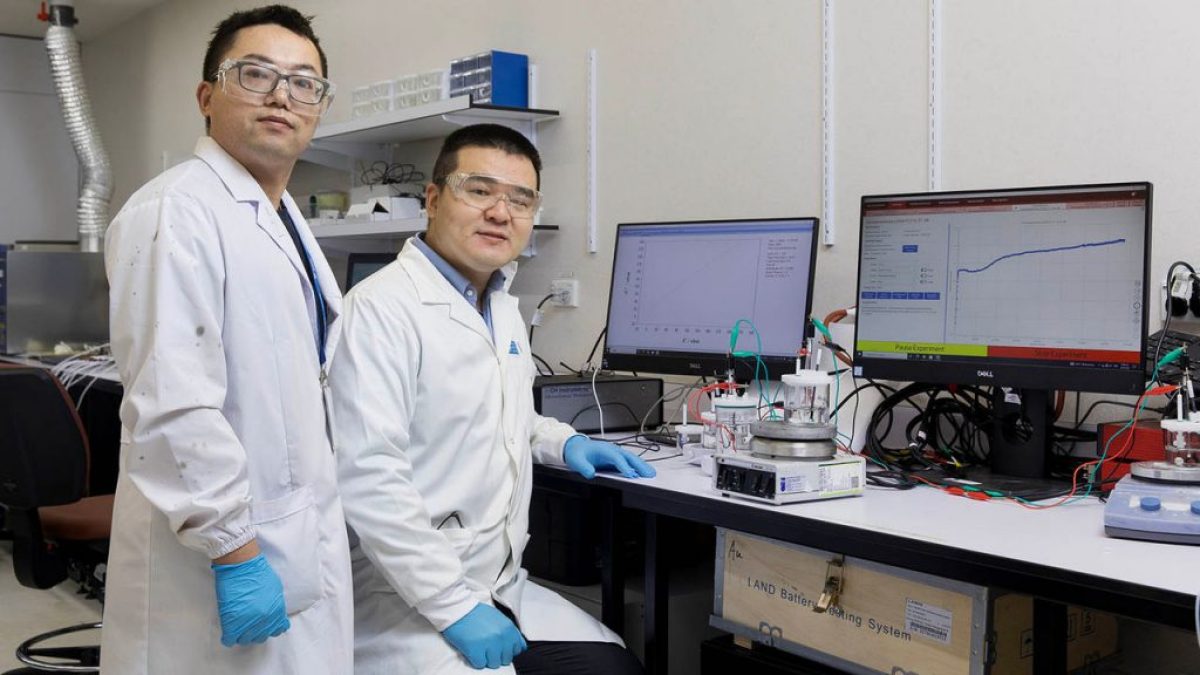From the scientific team that developed a new technology that captures carbon dioxide and turns it into fuel (University of Auckland)
In an effort to cleanse the atmosphere of global warming carbon dioxide, a scientific team from the University of Auckland in New Zealand, in collaboration with researchers at Chinese institutions, combined computational chemistry with electrochemical experiments to devise a way to convert carbon dioxide into formic acid.
This came through the development of a system that captures carbon dioxide from the atmosphere and converts it into formic acid and from there into useful chemical products or raw materials such as methanol and ethanol that can be used as fuel.
The new technology relies on the use of the process of electrolysis or electrochemical analysis, by creating a proton exchange membrane in the electrochemical cell, to reduce carbon dioxide to formic acid in a catalyst derived from waste lead-acid batteries.
This innovation is expected to open up exciting possibilities in the future, such as using fuel from cars and gas stations.
As industries grow, carbon dioxide becomes more concentrated in the atmosphere, which exacerbates climate change (Shutterstock)
The most dangerous greenhouse gases
Greenhouse gases are known as greenhouse gases. They are gases present in the Earth's atmosphere, the most important of which are carbon dioxide, methane, nitrous oxide, hydrochlorofluorocarbons, hydrofluorocarbons, and ozone in the lower layer of the atmosphere.
These gases are characterized by their ability to absorb infrared rays emitted by the Earth and re-emit them, which leads to raising the Earth’s temperature, thus exacerbating the phenomenon of global warming and global warming.
According to the World Meteorological Organization, the main problem lies in the increasing concentration of greenhouse gases in the atmosphere, most notably carbon dioxide resulting from the combustion of fossil fuels, whether from industrial facilities, power stations, or means of transportation, as more than 20 billion are released annually. tons in the Earth's atmosphere, which represents 0.7% of the amount of gas naturally present in the air.
Scientists seek to devise ways and methods to get rid of carbon dioxide by converting it into useful materials (Shutterstock)
Previous attempts
According to a previous study published in the journal Science Direct, various technologies have been developed to address the negative impact of rising levels of carbon dioxide in the atmosphere, including improving energy efficiency, capturing and using carbon dioxide, and developing bioenergy (such as growing algae to capture and reduce carbon dioxide). Or geological sequestration through carbon capture and storage in the ground and oceans, or the use of renewable energy sources that do not emit carbon dioxide (such as solar energy and wind energy), in addition to innovating ways and methods to get rid of carbon dioxide by converting it into useful materials. .
Among these matters is the conversion of carbon dioxide into formic acid, with the possibility of using it as a fuel for transportation and energy storage. This would enable the petrochemical industry to reduce carbon dioxide emissions and reduce its concentration in the atmosphere, which makes this process a necessity. To meet global environmental challenges.
The method developed by the researchers depends on using the process of chemical analysis to convert carbon dioxide into useful materials (Getty)
electrolysis
Electrolysis in chemistry and industry is the method by which an electric current is used to trigger a chemical reaction, using an electrochemical analysis cell. This process is important in separating elements from their forms found in nature, such as metals. Chemical analysis is also used to prepare materials that are difficult to prepare by chemical means or due to the high costs of chemical methods. Examples of this are found in the preparation of aluminium, chlorine, and pure sodium hydroxide solution.
A catalyst is often used in the process of electrochemical analysis, which is a chemical substance that is added in small quantities to the chemical reaction with the aim of accelerating the reaction without changing the properties of the chemicals, meaning that it is able to increase the speed of the chemical reaction by reducing the energy of the reaction or activating it without causing a chemical change. permanent.
According to a study published in the journal Nature, electrolysis, which reduces carbon dioxide into useful chemicals, can contribute to a more sustainable future and reduce the concentration of carbon dioxide in the atmosphere.
However, there are still some problems facing the process of reducing carbon dioxide by electrolysis, including the difficulty of precipitating carbon dioxide in the form of carbonate. To solve this problem, researchers developed a proton exchange membrane system that reduces carbon dioxide to formic acid during the electrochemical analysis process by feeding carbon dioxide into the electrochemical cell and converting it to formic acid and then into fuel, just like charging a battery, using a catalyst made from waste batteries. Lead acid, which allowed a transformation that was not possible before.
Scientists believe this process can be scaled up for industrial use in a cost-effective way and with potential applications in cars, gas stations and the petrochemical industry, this technology could help in the transition towards a zero-carbon economy and reduce greenhouse gas emissions.
“This innovation opens up exciting possibilities for carbon-neutral technologies, as it could be used in the future for cars and at petrol stations,” says Dr Xiyun Wang from the University of Auckland's School of Chemical Sciences.
Source: Al Jazeera + websites

